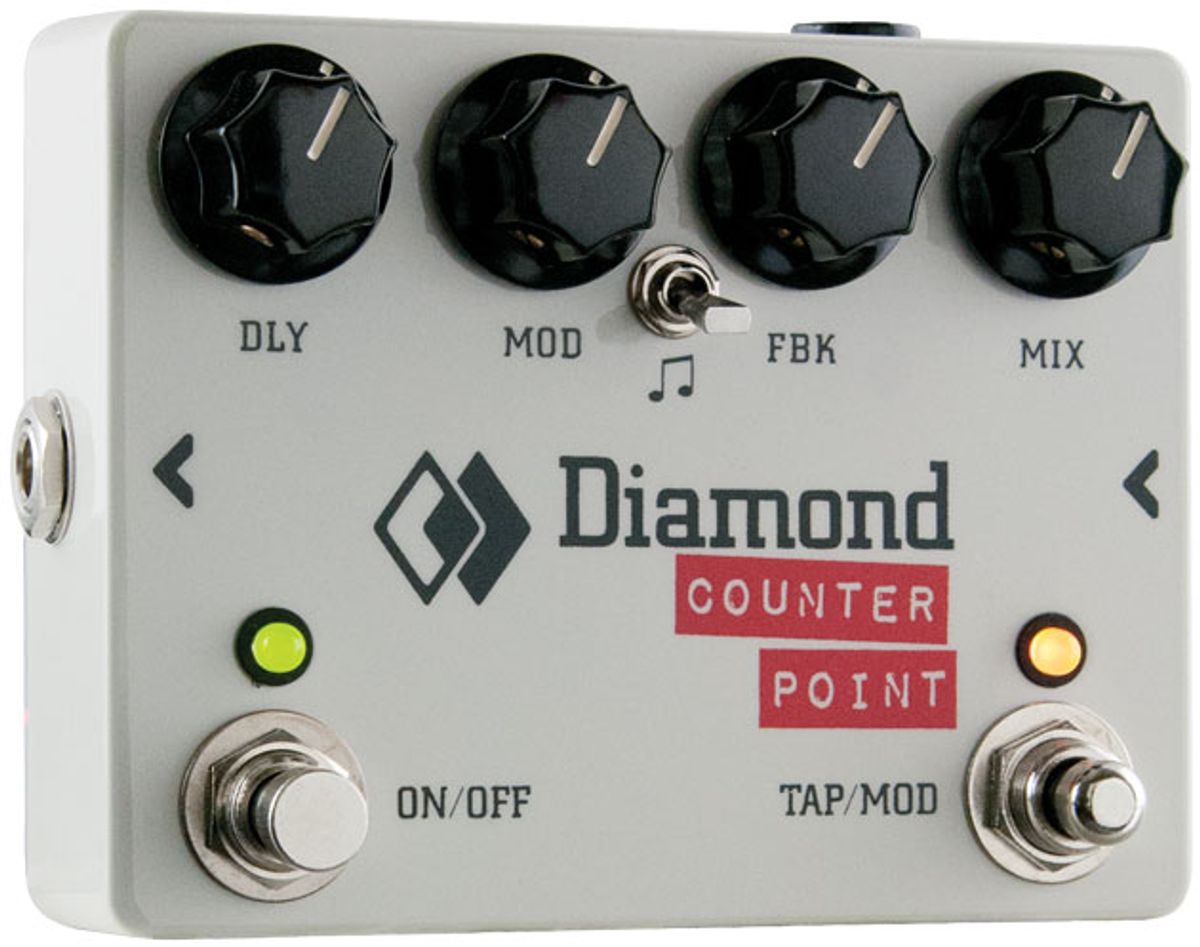
The brand’s newest digital delay spans five decades of delay sounds.
The Edge walks into a bar and says, “I’ll have a … Guinness.” The bartender replies, “Sure, mate—but why the delay?”
Yep, you know you’ve entered the musical pantheon when guitar nerds invent jokes about your sound. And when the nerds chase pedals that approximate that sound, you’ve reached another level entirely. Edge-obsessed players are bound to swoon over the new Diamond Counter Point digital delay, which excels at generating his signature dotted-eighth delays. But what makes this simple yet lush-sounding pedal special is the ease with which you can switch between ’80s tones, modern ambient colors, and ’60s-style quasi-tape echo.
Solid Simplicity
The Counter Point has controls for delay, modulation, feedback, and mix. Below these knobs is a toggle to select from the pedal’s four modes: vintage, galloping eighth, ambient, and extra faux tape. (A multicolored LED indicates the active mode.)
There’s a stout bypass footswitch, and another for tap tempo. The latter also adds or bypasses modulation when held down for one second. DIP switches in the battery compartment let you select spillover delay or true bypass. You can power the pedal via AC adapter or 9V battery.
Sailing Beyond The Edge
Analog mode is voiced much like Diamond’s Memory Lane Jr. The tone is darkish, but decays didn’t noticeably degrade with each repeat, an effect somewhere between digital and analog. The extra clarity is cool without sounding sterile. In this mode there’s 600 ms. of available delay time.
The second mode, gallop, is where you get your Edge and late-model Gilmour dotted-eighth sounds. It’s a forgiving and easy-to-use setting. And if it’s “Where The Streets Have No Name,” “Wire,” and “Run Like Hell” tones you want, just flip the toggle and fine-tune the delay time. A subtle quarter note rhythm blended with the dotted-note delays adds complexity to picked patterns and makes it easier to lock into a steady rhythm.
Ratings
Pros:
Digital clarity meets analog atmosphere. Easy to use. Remembers settings in a given mode.
Cons:
Labeling could be clearer.
Tones:
Ease of Use:
Build/Design:
Value:
Street:
$279
Diamond Pedals Counter Point Delay
diamondpedals.com/
Ambient mode is perfect for deep, washy mood pieces—a sort of alternate approach to ambient reverb. But here you get the long trails available on modern digital units—a nice blend of analog tone and digital possibilities.
Extra faux tape adds irregular tape-like modulation, which, to my ears, benefits from Counter Point’s digital clarity. You really hear the payoff at the maximum 1200 ms. delay time, where you can stack cascading patterns without getting too muddy.
Mondo Mod
The modulation control adds richness, though it’s really just a depth control. (Except in extra faux tape mode, the modulation rate is fixed.) A dash of depth adds a mellow chorus effect, while higher settings get downright woozy. The result isn’t always authentically tape-like, but it adds welcome texture and motion.
Another cool feature: Settings remain fixed as you toggle between modes. It’s not as flexible as having actual presets, but it’s a no-muss/no-fuss arrangement that works great in practice. Granted, it can be confusing when you see the rate knob at noon, but hear a slapback, though it’s easy to cope with this quirk.
This simplicity requires some tradeoffs. The mode switch’s label is a pair of eighth notes, when dotted eighths are but one setting. Relying on the LED color to indicate mode is also vague. If Counter Point ends up on my board, its beautiful face will definitely be defaced with Sharpie-scrawled tape.
The Verdict
Other delays make more radical sounds, and a dedicated slapback setting might have been nice. But the Counter Point’s savvy balance of simplicity and functionality makes it an ideal delay for many players.

